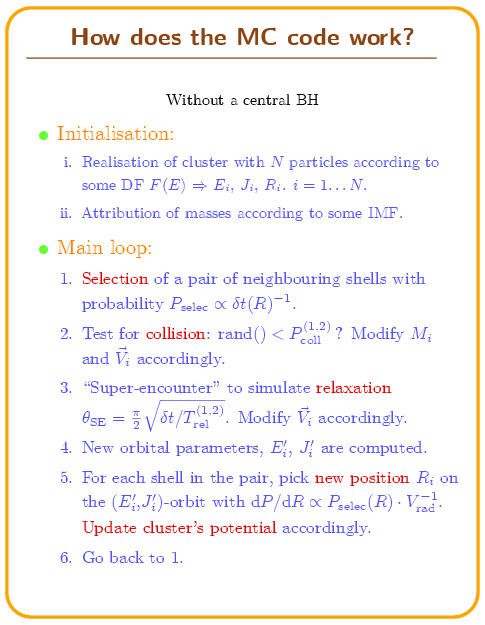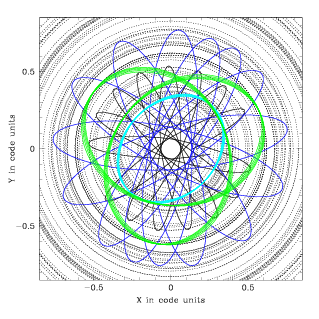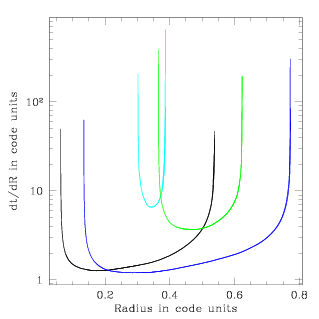
We won't cover the initialisation here, information may be found in (amongst others) Freitag & Benz 02 and Gürkan, Freitag & Rasio 04. Also check out the codes written by Atakan Gürkan (this link).
- Selection of a pair of neighbouring particles. Freitag's code keep Hénon's idea of time steps that are continuous function of the rank of the pair, i.e. its distance from the center. This allows to have a time step which follows the large variation of relaxation (and/or collision) time from the centre to the outskirts of the cluster

where f is a small number (of order 0.01).
In the MIT/NU code, all particles share the same time step (a small fraction of the central relaxation time). So, in contrast to Freitag's code, all succesive pairs are selected and updated in turn before the potential is recomputed for the new configuration of particles. Giersz's approach is somewhat intermediate, with the particles being grouped into radial super-zones. All particles in a super-zone share the same time-step and can be modified at the same time (before potential is recomputed). Successive super-zones are defined so that the time step is multiplied by a factor of 2 from one super-zone to the next. Special care has to taken as to when super-zone crossing is allowed.
In the MIT/NU code, all particles share the same time step (a small fraction of the central relaxation time). So, in contrast to Freitag's code, all succesive pairs are selected and updated in turn before the potential is recomputed for the new configuration of particles. Giersz's approach is somewhat intermediate, with the particles being grouped into radial super-zones. All particles in a super-zone share the same time-step and can be modified at the same time (before potential is recomputed). Successive super-zones are defined so that the time step is multiplied by a factor of 2 from one super-zone to the next. Special care has to taken as to when super-zone crossing is allowed.
- Collisions. Physical collisions between single stars is implemented in Freitag's code. Interaction with binary stars (single-binary and binary-binary) is featured in Giersz and MIT/NU codes. For collisions, one computes the probability of stars from the neighbouring particles comming into contact during the time step:

Pcoll is compared to a
[0,1[-random number. If this number is smaller tan Pcoll, a collision
occurs. The impact parameter is selected randomly as b=bmax*sqrt(X)
where X is another [0,1[-random number. The outcome of the collision
can be, for instance, determined by interpolation into a table of
pre-calculated SPH simulations (see the MODEST site on
stellar collisions). In the case of interaction with
binaries, R1+R2 is replaced by (some
factor times) the binary(ies) semi-major axis. In modern MC codes, the
outcome is given through direct integration of the 3- or 4-body
problem. Large-angle scatterings, not accounted for in the diffusive treatment of relaxation, can
be included in a way similar to collisions, with


with fl.a.
of order a few to include all events that lead to relatively large
deflection angle.
- Super-encounter. The cumulative effect of all encounters between stars with the properties (and relative velocity) of the paire during the time step is reproduced, statistically, by a single 2-body encounter with deflection angle θSE proportional to the square root of the time step (see the physical principles). The time step has to be kept small enough for most of these super-encounter to have relatively small θSE. Indeed, in order to get the proper effect of relaxation, averaged over all possible position on a given orbit, relative velocities and mass of the second star, one need to realise a large number of super-encounter before the orbital properties are significantly changed.
- Modification of the orbit. The velocity has been slightly changed. This correspond to a small change of the orbital constant.
- New position on the orbit.
A new position, i.e. a new radius for the shell is selected at random
acccording to the time spent at each position. In the smooth, spherical
potential defined by the collection of shells, orbits are rosettes. The
time spent at a given distance exhibits divergences at the peri- and
apo-centres. Implmenting such a probability density is a bit tricky,
see Hénon
71a or Freitag
& Benz 01.
Note that, unlike in N-body codes, the
change of position are discontinuous. If its eccentricity is large, a
particle can jump over a range of radius representing a significant
fraction of the cluster size in just one time step.
In Freitag's code, the potential is update after a particle has been moved around. An efficient way to do this is based on a binary tree structure.
In Freitag's code, the potential is update after a particle has been moved around. An efficient way to do this is based on a binary tree structure.

